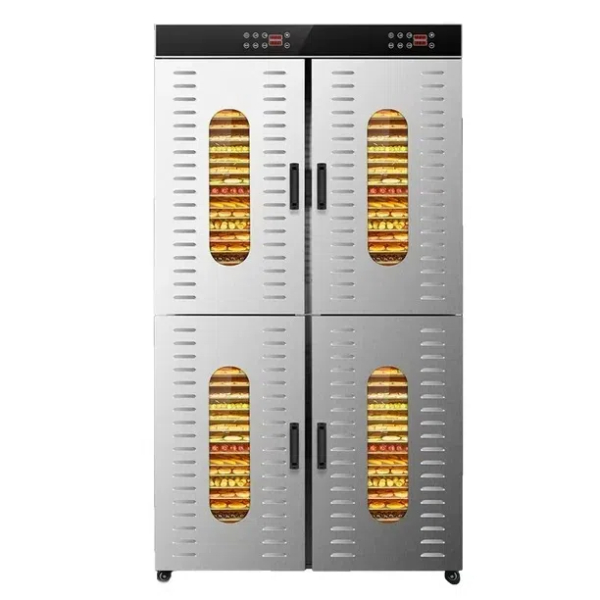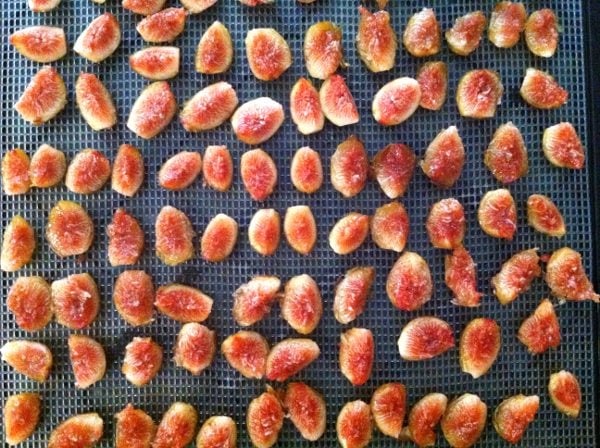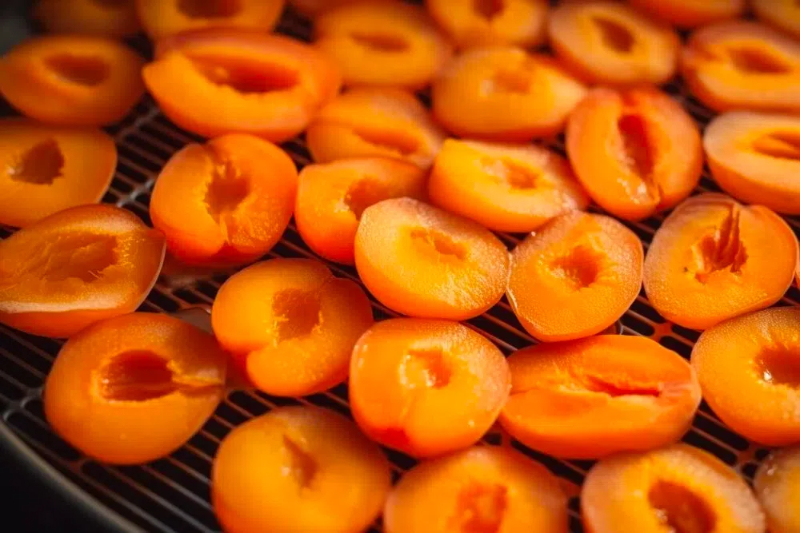Introduction
In the food processing industry, drying is a crucial step that significantly impacts the quality, shelf life, and marketability of food products. The choice of drying technology can influence energy consumption, product quality, and operational efficiency. This article explores the comparative advantages of heat pump drying systems versus traditional hanging drying systems, focusing on their mechanisms, efficiencies, and applications in food processing.

Understanding Drying Technologies
Heat Pump Drying (HPD)
Heat pump drying utilizes a refrigeration cycle to transfer heat from one location to another. This method is characterized by its ability to dry materials at lower temperatures while maintaining energy efficiency. The process involves:
- Evaporation: Moist air is drawn into the heat pump where it is cooled, causing moisture to condense.
- Heating: The condensed moisture is expelled, and the remaining air is heated before being circulated back into the drying chamber.
This closed-loop system allows for significant energy recovery and minimal environmental impact. The heat pump dryer operates efficiently even in lower ambient temperatures, making it suitable for various climates.
Traditional Hanging Systems
Traditional hanging drying systems rely on natural or forced air circulation to remove moisture from products. Common methods include:
- Sun Drying: Utilizing direct sunlight to evaporate moisture. This method is cost-effective but highly dependent on weather conditions.
- Hot Air Drying: Employing heated air from electric or fossil fuel sources. This method can be faster than sun drying but often results in uneven drying.
These methods often result in higher energy consumption and longer drying times due to their reliance on ambient conditions.
Efficiency Comparison
| Feature | Heat Pump Drying | Traditional Hanging Systems |
| Energy Consumption | Low (up to 10 times more efficient) | High |
| Temperature Control | Precise and adjustable | Limited control |
| Drying Time | Shorter due to controlled environment | Longer due to variable conditions |
| Environmental Impact | Minimal emissions | Higher emissions (especially fossil fuels) |
| Product Quality | Maintains nutritional value | Potential loss of quality |
Heat pump dryers are approximately ten times more efficient than traditional methods, making them a more sustainable choice for food processing industries.
Advantages of Heat Pump Systems
1. Energy Efficiency: Heat pumps can recover heat from exhaust air, significantly reducing energy costs. This efficiency translates into lower operational expenses over time.
2. Controlled Environment: The ability to control humidity and temperature leads to consistent product quality. This control is crucial for sensitive products like fruits and vegetables that require specific drying conditions.
3. Lower Operating Costs: While initial investment may be higher, operational savings over time make heat pumps economically viable. Businesses can expect a return on investment through reduced energy bills.
4. Flexibility: Suitable for various types of food products with different drying requirements. Heat pumps can be adjusted to accommodate different moisture levels and product types.
5. Sustainability: Reduced carbon footprint due to lower energy usage and minimal emissions. This aligns with global trends towards sustainable practices in food production.
6. Reduced Risk of Contamination: The closed system minimizes exposure to airborne contaminants that can occur in open-air drying methods.
Disadvantages of Traditional Systems
1. High Energy Usage: Often reliant on non-renewable energy sources leading to higher costs. The variability in energy prices can further affect profitability.
2. Quality Variability: Environmental factors can affect the consistency of the drying process. For example, fluctuations in humidity or temperature can lead to unevenly dried products.
3. Longer Drying Times: Increased risk of spoilage or loss of quality during extended drying periods. Products left out too long may attract pests or develop mold.
4. Dependence on Weather Conditions: Sun drying is highly dependent on favorable weather conditions, which can lead to unpredictable production schedules.
5. Labor Intensive: Traditional methods often require more manual labor for monitoring and handling products during the drying process.

Applications in Food Processing
Heat pump drying systems are particularly beneficial for:
1. Fruits and Vegetables: Preserving color, flavor, and nutrients while preventing enzymatic degradation.
2. Herbs and Spices: Maintaining volatile compounds that contribute to flavor and aroma.
3. Meats and Fish: Reducing spoilage while ensuring safety through controlled temperature settings.
4. Dairy Products: Efficiently removing moisture from cheese or yogurt powders without compromising quality.
5. Prepared Foods: Ideal for dehydrating meals for long-term storage without losing taste or nutritional value.
Traditional hanging systems are often used for:
1. Grains: Where ambient conditions may be favorable; however, they are still susceptible to pests.
2. Certain Vegetables: In regions with suitable climates for sun drying; however, this method may not be feasible year-round.
3. Traditional Cured Meats: Some artisanal processes still rely on hanging methods for specific flavors developed through exposure to air.
Technological Innovations in Heat Pump Drying
Recent advancements have further enhanced the capabilities of heat pump dryers:
1. Smart Control Systems: Modern heat pump dryers are equipped with IoT technology that allows remote monitoring and control via smartphones or computers, providing real-time data on temperature and humidity levels.
2. Energy Recovery Systems: Advanced models incorporate additional heat recovery systems that further improve energy efficiency by reusing waste heat generated during the drying process.
3. Modular Designs: New designs allow for scalability, enabling manufacturers to expand their operations without significant infrastructure changes.
4. Integration with Other Processes: Heat pump dryers can be integrated with other food processing technologies such as vacuum packaging or flash freezing, creating a seamless production line that maximizes efficiency.
5. Enhanced Automation: Automation features reduce labor costs by minimizing manual intervention during the drying process while ensuring consistent product quality.
Case Studies
Case Study 1: Fruit Processing Plant
A fruit processing plant transitioned from traditional sun drying methods to a heat pump dryer system. They reported a 60% reduction in energy costs and improved product quality with less spoilage during the drying process due to better temperature control.
Case Study 2: Herb Production Facility
An herb production facility adopted heat pump technology and experienced a 40% decrease in production time while maintaining higher flavor profiles in their dried herbs compared to previous methods.
Conclusion
The comparative analysis between heat pump and traditional hanging systems illustrates that heat pump technology offers superior efficiency, product quality preservation, and environmental sustainability. As the food processing industry continues to evolve towards more sustainable practices, heat pump dryers present a compelling option for manufacturers looking to optimize their operations while minimizing their ecological impact.
In conclusion, businesses must weigh their specific needs against the benefits offered by each system when choosing a drying method. However, as sustainability becomes increasingly important in global markets, investing in advanced technologies like heat pump dryers may provide a competitive edge while contributing positively to environmental goals.

FAQ
1. What is a heat pump dryer?
A heat pump dryer is an advanced drying system that uses a refrigeration cycle to remove moisture from materials at controlled temperatures.
2. How does heat pump drying compare in efficiency to traditional methods?
Heat pump drying can be up to ten times more efficient than traditional methods due to its ability to recover heat from exhaust air and operate at lower temperatures.
3. What types of food products benefit most from heat pump drying?
Fruits, vegetables, herbs, spices, meats, fish, dairy products, and prepared foods benefit significantly from heat pump drying as it preserves their nutritional value and quality.
4. Are there any downsides to using traditional hanging systems?
Yes, traditional hanging systems often result in higher energy consumption, longer drying times, potential variability in product quality due to environmental factors, dependence on weather conditions, and increased labor intensity.
5. Can heat pump dryers be used for large-scale production?
Absolutely! Heat pump dryers are versatile and can be scaled for large-scale production while maintaining efficiency and product quality.
Citations:
[1] http://www.scielo.org.za/scielo.php?script=sci_arttext&pid=S0038-23532014000300011
[2] https://patents.google.com/patent/CN110207480A/zh
[3] https://www.frontiersin.org/journals/nutrition/articles/10.3389/fnut.2024.1382296/full
[4] https://patents.google.com/patent/CN109252340A/zh
[5] https://www.researchgate.net/publication/351038022_Comparison_between_heat_pump_and_electric_heater_for_drying_onion_slices
[6] https://patents.google.com/patent/CN112481977B/zh
[7] https://www.researchgate.net/publication/238135948_Heat_pump_drying_Recent_developments_and_future_trends
[8] https://patents.google.com/patent/CN102268807A/pt-PT











